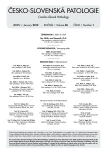Precanceroses of the endometrium, fallopian tube and ovary: a review of current conception
Authors:
P. Dundr
Authors‘ workplace:
Ústav patologie 1. LF UK v Praze a VFN
Published in:
Čes.-slov. Patol., 48, 2012, No. 1, p. 30-34
Category:
Reviews Article
Overview
Recently, there has been a significant increase of knowledge regarding the pathogenesis and genetic changes occurring in carcinomas of the female genital tract and also regarding the definition of their precursors. A dualistic model of endometrial carcinogenesis has been accepted for a long period of time. Recently, a similar concept has been proposed for ovarian carcinomas. A correct definition of cancer precursors is important for the understanding of tumor pathogenesis. Moreover, it has an impact on the prevention and therapy of these tumors. In this review we summarize the precancers of the endometrium, fallopian tube and ovary according to the most recent advances in this research.
Keywords:
atypical endometrial hyperplasia – endometrial glandular dysplasia – endometrial intraepithelial carcinoma – p53 signature – tubal intraepithelial carcinoma
Sources
1. Berman JJ, Albores-Saavedra J, Bostwick D, et al. Precancer: a conceptual working definition – results of a Consensus Conference. Cancer Detect Prev 2006; 30: 387–394.
2. Fadare O, Zheng W. Endometrial Glandular Dysplasia (EmGD): morphologically and biologically distinctive putative precursor lesions of Type II endometrial cancers. Diagn Pathol 2008; 8: 6.
3. Fadare O, Zheng W. Insights into Endometrial Serous Carcinogenesis and Progression. Int J Clin Exp Pathol 2009; 2: 411–432.
4. Zheng W, Xiang L, Fadare O, Kong B. A proposed model for endometrial serous carcinogenesis. Am J Surg Pathol 2011; 35: e1–e14.
5. Jia L, Liu Y, Yi X, Miron A, et al. Endometrial glandular dysplasia with frequent p53 gene mutation: a genetic evidence supporting its precancer nature for endometrial serous carcinoma. Clin Cancer Res 2008; 14: 2263–2269.
6. Tavassoli FA, Devilee P (Eds.) WHO Classification of tumours. Pathology and genetics tumours of the breast and female genital organs. IARC Press: Lyon 2004.
7. Mutter GL, Baak JPA, Crum CP, et al. Endometrial precancer diagnosis by histopathology, clonal analysis, and computerized morphometry. J Pathol 2000; 190: 462–469.
8. Hecht JL, Ince TA, Baak JPA, et al. Prediction of endometrial carcinoma by subjective endometrial intraepithelial neoplasia diagnosis. Mod Pathol 2005; 18: 324–330.
9. Salman MC, Usubutun A, Boynukalin K, Yuce K. Comparison of WHO and endometrial intraepithelial neoplasia classifications in predicting the presence of coexistent malignancy in endometrial hyperplasia. Gynecol Oncol 21; 2010: 97–101.
10. Vang R, Wheeler JE. Diseases of the fallopian tube and paratubal region. In: Kurman RJ, Ellenson LH, Ronnett BM, eds. Blaustein’s Pathology of the Female Genital Tract (6th ed). New York, NY: Springer; 2011: 453–527.
11. Crum CP, Lee KR (Eds). Diagnostic Gynecologic and Obstetric Pathology. Elsevier Saunders; 2006.
12. Lee Y, Miron A, Drapkin R, et al. A candidate precursor to serous carcinoma that originates in the distal fallopian tube. J Pathol 2007; 211: 26–35.
13. Shaw PA, Rouzbahman M, Pizer ES, Pintilie M, Begley H. Candidate serous cancer precursors in fallopian tube epithelium of BRCA1/2 mutation carriers. Mod Pathol 2009; 22: 1133–1138.
14. Chen EY, Mehra K, Mehrad M, et al. Secretory cell outgrowth, PAX2 and serous carcinogenesis in the Fallopian tube. J Pathol 2010; 222: 110–116.
15. Przybycin CG, Kurman RJ, Ronnett BM, Shih IeM, Vang R. Are all pelvic (nonuterine) serous carcinomas of tubal origin? Am J Surg Pathol 2010; 34: 1407–1416.
16. Cho KR. Ovarian cancer update: lessons from morphology, molecules, and mice. Arch Pathol Lab Med 2009; 133: 1775–1781.
17. Köbel M, Kalloger SE, Santos JL, et al. Tumor type and substage predict survival in stage I and II ovarian carcinoma: insights and implications. Gynecol Oncol 2010; 116: 50–56.
18. Kurman RJ, Shih IM. The origin and pathogenesis of epithelial ovarian cancer: a proposed unifying theory. Am J Surg Pathol 2010; 34: 433–443.
19. Shih IM, Kurman RJ. Ovarian tumorigenesis: a proposed model based on morphological and molecular genetic analysis. Am J Pathol 2004; 164: 1511–1518.
20. Kurman RJ, Shih IM. Molecular pathogenesis and extraovarian origin of epithelial ovarian cancer-Shifting the paradigm. Hum Pathol 2011; 42: 918–931.
21. Irving JA, Clement PB. Disease of the peritoneum. In: Kurman RJ, Ellenson LH, Ronnett BM, eds. Blaustein’s Pathology of the Female Genital Tract (6th ed). New York, NY: Springer; 2011: 453–527.
22. Prefumo F, Venturini VL, Fulcheri E. Anylysis of p53 and c-erb-2 expression in ovarian endometrioid carcinomas arising in endometriosis. Int J Gynecol Pathol 2002; 22: 83–88.
23. Li J, Abushahin N, Pang S, et al. Tubal origin of ‘ovarian’ low-grade serous carcinoma. Mod Pathol. In press 2011.
Labels
Anatomical pathology Forensic medical examiner ToxicologyArticle was published in
Czecho-Slovak Pathology

2012 Issue 1
Most read in this issue
- Gynaecological precanceroses from the clinical perspective – today and tomorrow
- Review of precancerous vulvar lesions
- What is new in cervical precanceroses cytodiagnostics?
- Precanceroses of the endometrium, fallopian tube and ovary: a review of current conception
